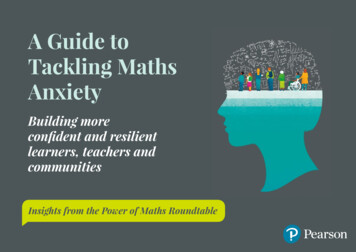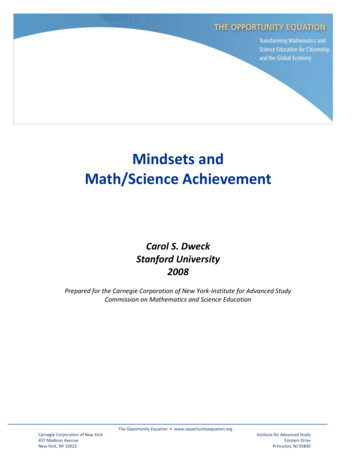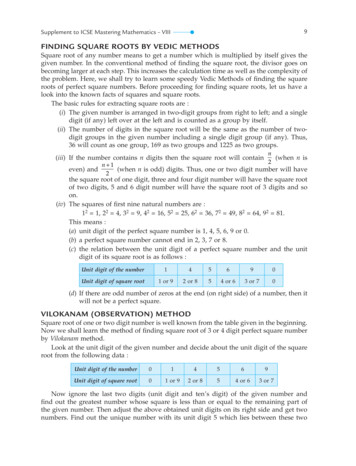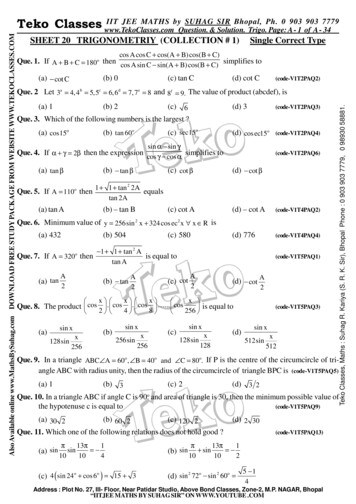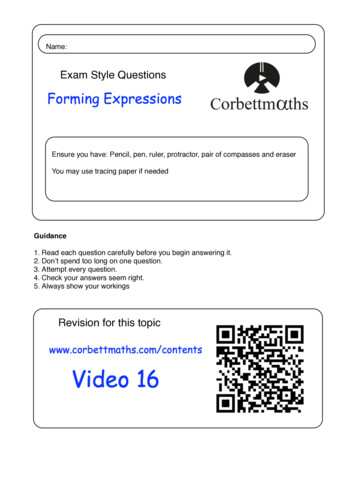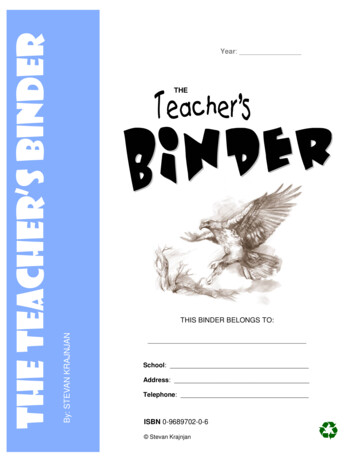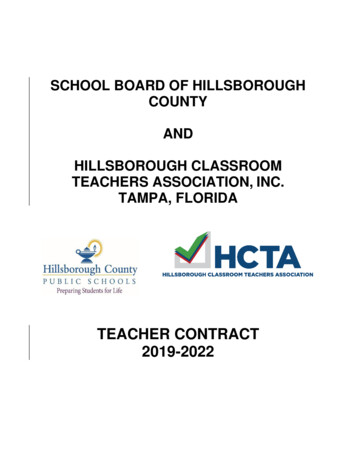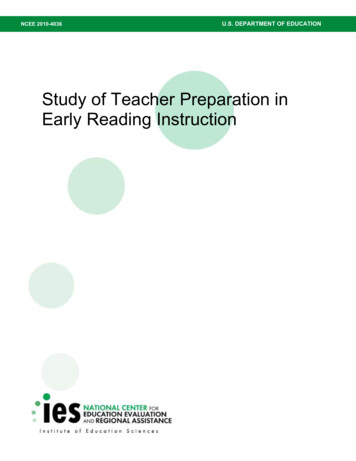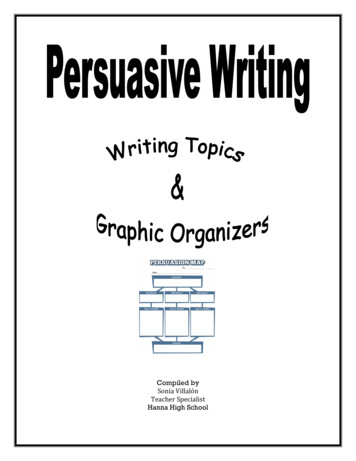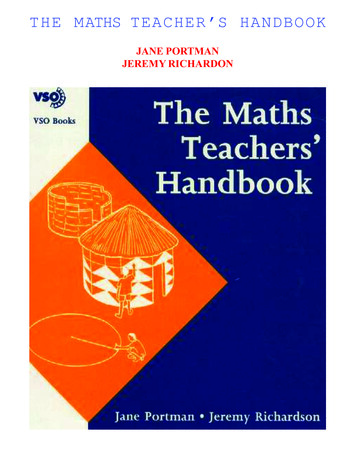
Transcription
THE MATHS TEACHER’S HANDBOOKJANE PORTMANJEREMY RICHARDON
INTRODUCTIONWho is this book for?This book is for mathematics teachers working in higher primary andsecondary schools in developing countries. The book will help teachersimprove the quality of mathematical education because it dealsspecifically with some of the challenges which many maths teachers inthe developing world face, such as a lack of ready-made teaching aids,possible textbook shortages, and teaching and learning maths in asecond language.Why has this book been written?Teachers all over the world have developed different ways to teach mathssuccessfully in order to raise standards of achievement. Maths teachershave developed ways of using locally available resources adapted mathematics to their own cultural contexts and to the tasks andproblems in their own communities introduced local maths-related activities into their classrooms improved students’ understanding of English in the mathsclassroom.This book brings together many of these tried and tested ideas fromteachers worldwide, including the extensive experience of VSO mathsteachers and their national colleagues working together in schoolsthroughout Africa, Asia, the Caribbean and the Pacific.We hope teachers everywhere will use the ideas in this book to helpstudents increase their mathematical knowledge and skills.What are the aims of this book?This book will help maths teachers: find new and successful ways of teachingmaths make maths more interesting and morerelevant to their students understand some of the language andcultural issues their studentsexperience.Most of all, we hope this book willcontribute to improving the quality ofmathematics education and to raisingstandards of achievement.
WHAT ARE THE MAIN THEMES OF THIS BOOK?There are four main issues in the teaching and learning ofmathematics:Teaching methodsStudents learn best when the teacher uses a wide range of teachingmethods. This book gives examples and ideas for using many differentmethods in the classroom,Resources and teaching aidsStudents learn best by doing things: constructing, touching, moving,investigating. There are many ways of using cheap and availableresources in the classroom so that students can learn by doing. Thisbook shows how to teach a lot using very few resources such as bottletops, string, matchboxes.The language of the learnerLanguage is as important as mathematics in the mathematicsclassroom. In addition, learning in a second language causes specialdifficulties. This book suggests activities to help students use languageto improve their understanding of maths.The culture of the learnerStudents do all sorts of maths at home and in their communities. Thisis often very different from the maths they do in school. This bookprovides activities which link these two types of rnaths together.Examples are taken from all over the world. Helping students make thislink will improve their mathematics.
HOW DID WE SELECT THE ACTIVITIES AND TEACHINGIDEAS IN THIS BOOK?There are over 100 different activities in this book which teachers can useto help vary their teaching methods and to promote students’understanding of maths.The activities have been carefully chosen to show a range of different teachingmethods, which need few teaching aids. The activities cover a wide rangeof mathematical topics.Each activity: shows the mathematics to be learned contains clear instructions for students introduces interesting ways for students to learn actively.What is mathematics?Mathematics is a way of organising our experience of the world. Itenriches our understanding and enables us to communicate and makesense of our experiences. It also gives us enjoyment. By doingmathematics we can solve a range of practical tasks and real-lifeproblems. We use it in many areas of our lives.In mathematics we use ordinary language and the special language ofmathematics. We need to teach students to use both these languages.We can work on problems within mathematics and we can work onproblems that use mathematics as a tool, like problems in science andgeography. Mathematics can describe and explain but it can also predictwhat might happen. That is why mathematics is important.Learning and teaching mathematicsLearning skills and remembering facts in mathematics are important butthey are only the means to an end. Facts and skills are not important inthemselves. They are important when we need them to solve a problem.Students will remember facts and skills easily when they use them tosolve real problems.As well as using mathematics to solve real-life problems, students shouldalso be taught about the different parts of mathematics, and how they fittogether.Mathematics can be taught using a step-by-step approach to a topic but itis important to show that many topics are linked, as shown in the diagramon the next page.It is also important to show students that mathematics is done all over theworld.
34123412341234Although each country may have a different syllabus, there are manytopics that are taught all over the world. Some of these are: number systems and place value arithmetic algebra geometry statistics trigonometry probability graphs measurementWe can show students how different countries have developeddifferent maths to deal with these topics.How to use this bookThis book is not simply a collection of teaching ideas and activities. Itdescribes an approach to teaching and learning mathematics.This book can be best used as part of an approach to teaching using aplan or scheme of work to guide your teaching. This book is only oneresource out of several that can be used to help you with ideas foractivities and teaching methods to meet the needs of all pupils and toraise standards of achievement.There are three ways of using this book:Planning a topicUse your syllabus to decide which topic you are going to teach next, Findthat topic in the index at the back of the book. Turn to the relevant pagesand select activities that are suitable. We suggest that you try theactivities yourself before you use them in the classroom. You might like todiscuss them with a colleague or try out the activity on a small group ofstudents. Then think about how you can or need to adapt and improve theactivity for students of different abilities and ages.
Improving your own teachingOne way to improve your own teaching is to try new methods andactivities in the classroom and then think about how well the activityimproved students’ learning. Through trying out new activities andworking in different ways, and then reflecting on the lesson andanalysing how well students have learned, you can develop the bestmethods for your students.You can decide to concentrate on one aspect of teaching maths:language, culture, teaching methods, resources or planning. Findthe relevant chapter and use it.Working with colleaguesEach chapter can be used as material for a workshop withcolleagues. There is material for workshops on: developing different teaching methods developing resources and teaching aids culture in the maths classroom language in the maths classroom planning schemes of work.In the workshops, teachers can try out activities and discuss theissues raised in the chapter. You can build up a collection ofsuccessful activities and add to it as you make up your own,individually or with other teachers.
CHAPTER 1TEACHING METHODSThis chapter is about the different ways you can teach a topic in theclassroom. Young people learn things in many different ways. Theydon’t always learn best by sitting and listening to the teacher.Students can learn by: practising skills on their own discussing mathematics with each other playing mathematical games doing puzzles doing practical work solving problems finding things out for themselves.In the classroom, students need opportunities to use different waysof learning. Using a range of different ways of learning has thefollowing benefits: it motivates students it improves their learning skills it provides variety it enables them to learn things more quickly.We will look at the following teaching methods:1 Presentation and explanation by the teacher2 Consolidation and practice3 Games4 Practical work5 Problems and puzzles6 Investigating mathematicsPresentation and explanationby the teacherThis is a formal teaching method which involves the teacherpresenting and explaining mathematics to the whole class. It can bedifficult because you have to ensure that all students understand.This can be a very effective way of: teaching a new piece of mathematics to a large group of students drawing together everyone’s understanding at certain stages of atopic summarising what has been learnt,Planning content before the lesson: Plan the content to be taught. Check up any points you are notsure of. Decide how much content you will cover in the session.
Identify the key points and organise them in a logical order. Decidewhich points you will present first, second, third and so on. Choose examples to illustrate each key point. Prepare visual aids in advance. Organise your notes in the order you will use them. Cards can beuseful, one for each key point and an example.Planning and organising time Plan carefully how to pace each lesson. How much time will yougive to your presentation and explanation of mathematics? Howmuch time will you leave for questions and answers by students?How much time will you allow for students to practise newmathematics, to do different activities like puzzles, investigations,problems and so on? With careful planning and clear explanations, you will find that youdo not need to talk for too long. This will give students time to domathematics themselves, rather than sitting and listening to youdoing the work.You need to organise time: to introduce new ideas for students to complete the task set for students to ask questions to help students understand to set and go over homework for practical equipment to be set up and put away for students to move into and out of groups for different activities.Organising the classroom Organise the classroom so that all students will be able to see youwhen you are talking. Clean the chalkboard. If necessary, prepare notes on thechalkboard in advance to save time in the lesson. Arrange the teacher’s table so that it does not restrict yourmovement at the front of the class. Place the table in a positionwhich does not create a barrier between you and the students. Organise the tables and chairs for students according to the type ofactivity:- facing the chalkboard if the teacher is talking to the wholegroup- in circles for group work. Develop a routine for the beginning of each lesson so that allstudents know what behaviour is expected of them from thebeginning of the session. For example, begin by going overhomework. Create a pleasant physical environment. For example, displaystudents’ work and teaching resources - create a ‘puzzle corner’.
Performance It is very important that your voice is clear and loud enough for allstudents to hear. Vary the pitch and tone of your voice. Ask students questions at different stages of the lesson to check theyhave understood the content so far. Ask questions which will makethem think and develop their understanding as well as show you thatthey heard what you said. For new classes, learn the names of students as quickly aspossible. Use students’ names when questioning. Speak with conviction. If you sound hesitant you may losestudents’ confidence in you. When using the chalkboard, plan carefully where you write things. Ithelps to divide the board into sections and work through eachsection systematically. Try not to end a lesson in the middle of a teaching point orexample. Plan a clear ending to the session.Ground rules for classroom behaviour Students need to know what behaviour is acceptable andunacceptable in the classroom. Establish a set of ground rules with students. Display the rules in theclassroom. Start simply with a small number of rules of acceptable behaviour. Forexample, rules about entering and leaving the room and rules aboutstarting and finishing lessons on time. Identify acceptable behaviour in the following situations:- when students need help- when students need resources- when students have forgotten to bring books or homework to thelesson- when students find the work too easy or too hard.
Consolidation and practiceIt is very important that students have the opportunity topractise new mathematics and to develop theirunderstanding by applying new ideas and skills to newproblems and new contexts.The main source of exercises for consolidation and practiceis the text book.It is important to check that the examples in the exercisesare graded from easy to difficult and that students don’t startwith the hardest examples. It is also important to ensure thatwhat is being practised is actually the topic that has beencovered and not new content or a new skill which has notbeen taught before.This is a very common teaching method. You should takecare that you do not use it too often at the expense of othermethods.Select carefully which problems and which examplesstudents should do from the exercises in the text book.Students can do and check practice exercises in a variety ofways. For example: Half the class can do all the odd numbers. The other halfcan do the even numbers. Then, in groups, students cancheck their answers and, if necessary, do corrections. Anyprobiems that cannot be solved or agreed on can be givento another group as a challenge. Where classes are very large, teachers can mark aselection of the exercises, e.g. all odd numbers, or thoseexamples that are most important for all students to docorrectly. To check homework, select a few examples that need tobe checked. Invite a different student to do each exampleon the chalkboard an
the developing world face, such as a lack of ready-made teaching aids, possible textbook shortages, and teaching and learning maths in a second language. Why has this book been written? Teachers all over the world have developed dif ferent ways to teach maths successfully in order to raise standards of achievement. Maths teachers have developed ways of using locally available resources .
